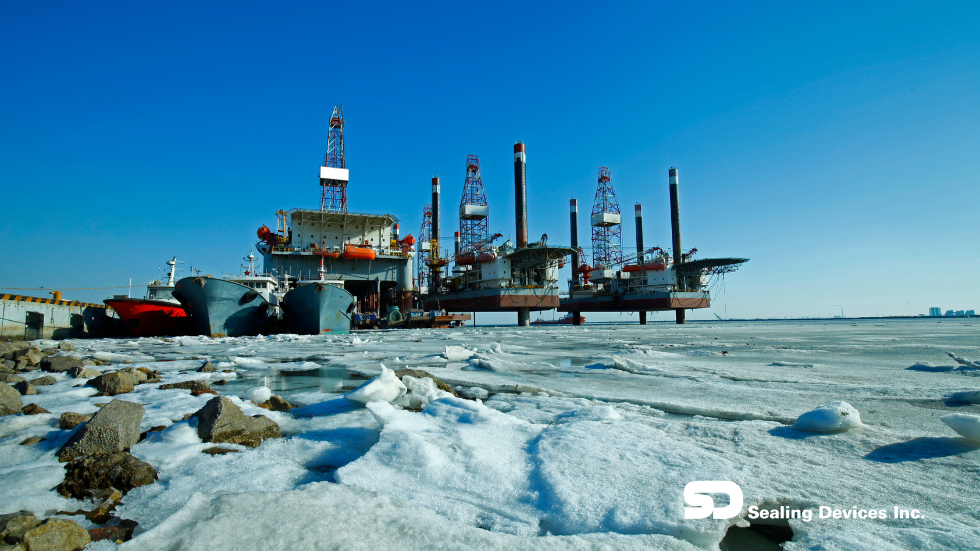When seals fail in fuel systems, the cost quickly goes beyond the price of an O-ring. You’re looking at
unplanned downtime, field service calls, warranty claims, and unhappy end customers — especially in
aerospace and other high-stakes markets.
For buyers and sourcing teams, Parker’s VX065 low-temperature fluorocarbon (FKM) offers a way
to reduce those risks, simplify material strategies, and stay ahead of Sustainable Aviation Fuel (SAF)
requirements — all with a single, qualified compound, available through distributors like
Sealing Devices.
One Material for Deep Cold and High Heat
From a purchasing standpoint, VX065’s biggest advantage is that it covers a very wide operating window:
- –65 °F low-temperature sealing
- +400 °F high-temperature capability, with limited higher excursions
That allows many programs to consolidate multiple elastomer types (like NBR for cost, fluorosilicone for cold, and other FKMs for heat) into one long-life compound in many fuel and oil applications.
Fewer materials mean:
- Simpler qualification and documentation
- Less complexity in stocking and inventory
- Lower risk of the wrong material being installed in the field
Longer Seal Life = Lower Total Cost
Many organizations still specify fluorosilicone for fuel sealing simply because it’s what they’ve always used.
But in practice, that choice can quietly drive higher lifecycle costs.
In customer feedback summarized by Parker, a typical pattern has emerged:
- Fluorosilicone seals in fuel service often last only about 6,000–8,000 hours.
- Parker VX065 fluorocarbon seals have been reported to last around 40,000 hours and remain in very good condition.
For buyers, that translates into:
- Fewer rebuilds and maintenance interventions
- Less downtime for equipment and aircraft
- Lower warranty exposure and fewer emergency orders
Even if VX065 carries a higher unit price than fluorosilicone in some sizes, the total cost of ownership strongly favors VX065 in high-value fuel systems.
SAF-Ready: Answering the “Are You Compatible?” Question
More and more, customers are asking a simple question that has big implications:
“Are your components compatible with Sustainable Aviation Fuel (SAF)?”
That question is already showing up on RFQs and long-term agreements. Traditional materials for jet fuel — such as NBR, fluorosilicone, and legacy low-temp FKMs — may not all perform reliably with newer SAF blends, which tend to be more aggressive toward seal materials.
Parker’s data and field experience show that VX065 has very good chemical resistance and compatibility with SAF, especially compared to fluorosilicone.
By specifying VX065, you can:
- Give a confident “yes” when customers ask about SAF compatibility
- Avoid costly redesigns later if legacy materials fall short
- Position your products as future-ready without juggling multiple elastomer variants
Qualification and Supply Security: VX065 on the QPL
In regulated industries, qualification status is just as important as performance. There is a Qualified Products List (QPL) for fluorocarbon materials rated to –65 °F, and Parker’s VX065 is currently the only compound on that list, backed by multiple Parker manufacturing facilities.
For procurement, that means:
- You’re buying a qualified compound, not just a lab material
- Multiple approved facilities reduce single-source risk
- Qualification support makes it easier to address audits and customer documentation requirements, especially in aerospace programs
Flexible Forms for Real-World Programs
VX065 isn’t limited to one part type. It’s already being produced in multiple geometries:
- Standard and custom O-rings
- Custom molded seals and D-rings
- Extruded VX065 cord that can be spliced to size, supplied coiled or spooled for flexible stocking strategies
That gives your engineering and production teams more options under a single material umbrella and makes it easier to standardize VX065 across assemblies and platforms.
How VX065 Helps Buyers Simplify and De-Risk
1. Fewer Materials to Manage
VX065 can replace or reduce the use of separate NBR, fluorosilicone, and other low-temp FKMs in many fuel sealing applications. This simplifies your approved material list, purchasing processes, and inventory.
2. Lower Lifecycle Costs
Higher seal life (up to around 40,000 hours in reported applications) means fewer replacements, less downtime, and lower warranty risk — even when VX065 isn’t the cheapest option per piece.
3. SAF and Future Fuel Readiness
With VX065, you can confidently support both conventional jet fuel and SAF, instead of managing separate compounds for each. That’s a straightforward way to de-risk future fuel transitions.
4. Qualification Confidence
Being the only –65 °F fluorocarbon on the QPL, with multiple listed facilities, gives you a defensible, audit-ready choice for demanding customers.
5. Strong Supplier Support
Working with Parker and distributors like Sealing Devices, you can tap into engineering support, stocking programs, and custom geometries — all based on a proven compound.
Buyer FAQ: VX065 for Fuel Sealing
Will VX065 increase my piece price?
In some cases, yes. However, VX065 typically reduces total cost by extending service life,
cutting downtime, and lowering warranty risk. In critical fuel systems, those savings usually outweigh
a modest increase in unit cost.
Do I need separate materials for SAF and conventional jet fuel?
Not necessarily. VX065 can support both conventional jet fuel and SAF in many applications, reducing the
need to qualify and stock multiple compounds for different fuel types.
Is VX065 hard to source?
No. VX065 is produced at multiple Parker facilities and is available in a range of configurations through
authorized distributors like Sealing Devices. That multi-site support helps reduce supply chain risk.
How do I start transitioning programs to VX065?
A practical first step is to identify where fluorosilicone or NBR are driving performance issues,
field failures, or high maintenance costs. From there, you can work with Sealing Devices and your
Parker contacts to cross-reference those part numbers and migrate them to VX065 (or the higher-duro
VX365 companion compound) where appropriate.
